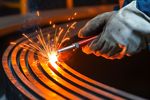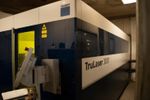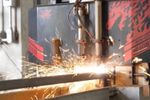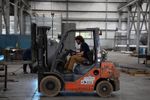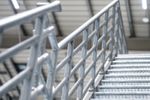Did you opt for off-the-shelf material handling equipment instead of developing custom material handling solutions? Your setup could be costing you more than you realize. Back injuries, employee absences, damaged parts, and poor space utilization are just some of the problems that result when material handling equipment isn’t optimized for the task.
Carts, racks, and positioners bought from the catalog are “one-size-fits-all” approaches that never work exactly the way you need. The answer is to invest in developing custom material handling solutions specifically designed for the type of work you do — and the way you do it.
The Trouble with Material Handling
Moving materials, parts, tools or equipment around a facility adds no value to what you sell but always has a cost. If you don’t do it in the leanest, most ergonomic, most efficient manner possible, it will end up costing more than it should.
OSHA reports that, “Manual materials handling is the principal source of compensable injuries in the American work force.” Lifting, twisting, and bending cause many back injuries, most of which could be avoided with better material handling equipment.
Handling solutions that let parts and materials get scratched or otherwise damaged aren’t solutions at all. They’re actually problems. Wheeled carts and totes shake the parts held on them, and if each isn’t precisely located, they’ll rub and scratch. This imprecision leads to rework — or maybe even scrap.
Intermediate storage locations abound throughout most manufacturing operations. (It’s called “work-in-progress” even though it’s not being worked on.) Poorly designed storage uses precious floor space inefficiently, making workers do too much lifting, bending, and turning.
On the other hand, when racks, pallets and shelving are designed specifically for products, more gets stored in a smaller area and ergonomics improve. Plus, some manufacturers use the storage equipment as a form of Kanban signal.
Advantages of Custom Material Handling Solutions
Opting for custom material handling solutions is like getting a suit made-to-measure rather than one off-the-shelf: It fits better.
In this case, “fit” refers to how the materials are held. Components such as stamped parts, moldings, or castings won’t slide around. Instead, they’ll be located precisely and repeatably. An added benefit is that it may be possible to fit more on a cart, reducing the number of trips needed in the process.
Custom material handling solutions presents tools at the height needed. That way there’s less lifting, which reduces back strain. Sometimes it’s even possible to get all the tools needed for a particular job onto a single cart, cutting machine changeover time.
Another example where custom material handling solutions shine is the instrumentation cart. A technician wheels this to wherever test measurements are needed. If it’s not designed for the equipment, the tech might need twice as many carts. Or, he or she may risk overloading with precariously balanced meters and ’scopes. When a cart designed and made specifically for the job is used, it keeps the equipment safe and even speeds up getting tests performed.
Work positioners are another excellent application ripe for custom material handling solutions. Work positioners are widely used in assembly. They hold a large component or sub-assembly at a height and orientation that makes the operation as easy as possible. This puts less strain on the person doing the work, reducing fatigue and lessening the risk of errors and injuries.
Sourcing Custom Material Handling Solutions for Your Factory
There are two ways to go about getting custom material handling equipment fabricated: design it yourself around the parts or tools, or present an experienced fabrication shop with the challenge.
The risk with the first approach is that you’ll get exactly what you asked for. Sure, it will do the job, but you’ll have missed out on an opportunity to incorporate improvements born of experience in the field.
A custom metal fabricator with expertise in carts and totes will almost certainly have ideas to offer. They’ll be able to suggest proven materials and methods of construction. Perhaps drawers would work better than open shelves? Maybe baskets have advantages over racks? They’ll also know what’s easier (and therefore cheaper) to build — and what features are difficult or expensive to fabricate.
Ideally, your preferred fabricator will have turnkey capabilities. They’ll perform every step, from cutting bar stock to painting or powder coating. That saves on transport, reduces delivery time, and — more importantly — helps ensure you get exactly what you want and need.
Cutting Material Handling Costs with Custom Fabrication
Moving and storing materials adds no value but always carries a cost. When material handling equipment isn’t configured to your specific needs, it’s likely that this cost is higher than you realize — or than it needs to be.
Moreover, poor ergonomics may be leading to back injuries and fatigue that result in employee absences and errors. Parts may be getting damaged, increasing scrap costs, and even delaying shipments. And expensive test equipment could be at risk of damage.
Custom material handling solutions may sound extravagant, but in reality, it’s the opposite. Catalog equipment is probably costing you more than you know, and going custom will save you in the long run.
To learn more about what an experienced custom metal fabricator can bring to the table when it comes to creating custom material handling solutions, please contact us here at Southern Metal Fabricators.

